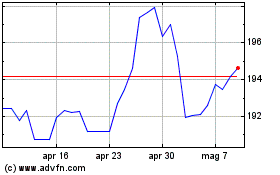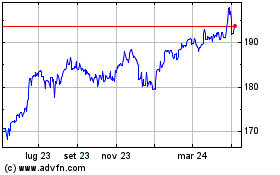Yen Trades Higher Amid Virus Fears
09 Marzo 2020 - 5:15AM
RTTF2
The Japanese yen traded higher against its major counterparts on
Monday amid risk aversion, as a plunge in crude oil prices added to
worries about the rapid spread of the coronavirus outbreak across
the world.
Crude oil plummeted amid fears of a price war after a proposal
by the Organization of the Petroleum Exporting Countries or OPEC
for deeper output cuts was rejected by its allies. Saudi Arabia
slashed its official oil prices and reportedly plans to ramp up
production following the breakdown in talks between OPEC and
Russia.
Data showed China's exports contracted sharply in the first two
months of the year, worsening a global market rout.
China's exports and imports both plunged over the first two
months of the year due to the virus impact, customs data
showed.
Exports shrank by 17.2 percent in January and February combined,
down from 7.9 percent growth in December. Imports dropped an annual
4 percent, down from 16.5 percent growth in December.
Data from the Cabinet Office showed that Japan's gross domestic
product saw a downward revision to -7.1 percent on year in the
fourth quarter of 2019.
That was worse than expectations for -6.6 percent after last
month's preliminary reading suggested a decline of 6.3 percent.
The yen rose to a 3-1/2-year high of 101.54 against the
greenback and more than a 6-month high of 116.36 against the euro,
from its early low of 104.60 and a 1-week low of 118.70,
respectively. Next key resistance for the yen is seen around 100.00
against the greenback and 114.00 against the euro.
Reversing from its early lows of 112.27 against the franc and
136.86 against the pound, the yen spiked up to a 3-month high of
110.06 and a 5-month high of 132.89, respectively. If the yen rises
further, 107.00 and 130.5 are likely seen as its next resistance
levels against the franc and the pound, respectively.
The yen moved up to more than an 8-year high of 73.86 against
the loonie, 7-1/2-year high of 61.29 against the kiwi and an
11-year high of 64.49 against the aussie, from its early more than
3-year low of 77.02, multi-year lows of 66.14 and 69.17,
respectively. The next possible resistance for the yen is seen
around 72.00 against the loonie, 60.00 against the kiwi and 61.00
against the aussie.
The Australian and New Zealand dollars fell amid a plunge in
Asian shares.
The aussie fell to an 11-year low of 0.6314 against the
greenback and near an 11-year low of 1.8146 against the euro, from
its early high of 0.6625 and a multi-year high of 1.7125,
respectively. The aussie is seen finding support around 0.63
against the greenback and 1.85 against the euro.
The aussie dropped to a 6-day low of 0.8717 against the loonie
and near a 5-week low of 1.0370 against the kiwi, reversing from
its early 1-1/2-month high of 0.9016 and a 4-day high of 1.0510,
respectively. The aussie may locate support around 0.85 against the
loonie and 1.02 against the kiwi.
The kiwi depreciated to near an 11-year low of 0.6008 against
the greenback and a 9-year low of 1.9127 against the euro, off its
early highs of 0.6342 and 1.7932, respectively. The kiwi is poised
to challenge support around 0.58 against the greenback and 2.1
against the euro.
Looking ahead, Eurozone Sentix investor confidence for March is
due out in the European session.
At 8:15 am ET, Canada housing starts for February are set for
release.
Canada building permits for January will be released in the New
York session.
Grafico Cross Sterling vs Yen (FX:GBPJPY)
Da Mar 2024 a Apr 2024

Grafico Cross Sterling vs Yen (FX:GBPJPY)
Da Apr 2023 a Apr 2024
